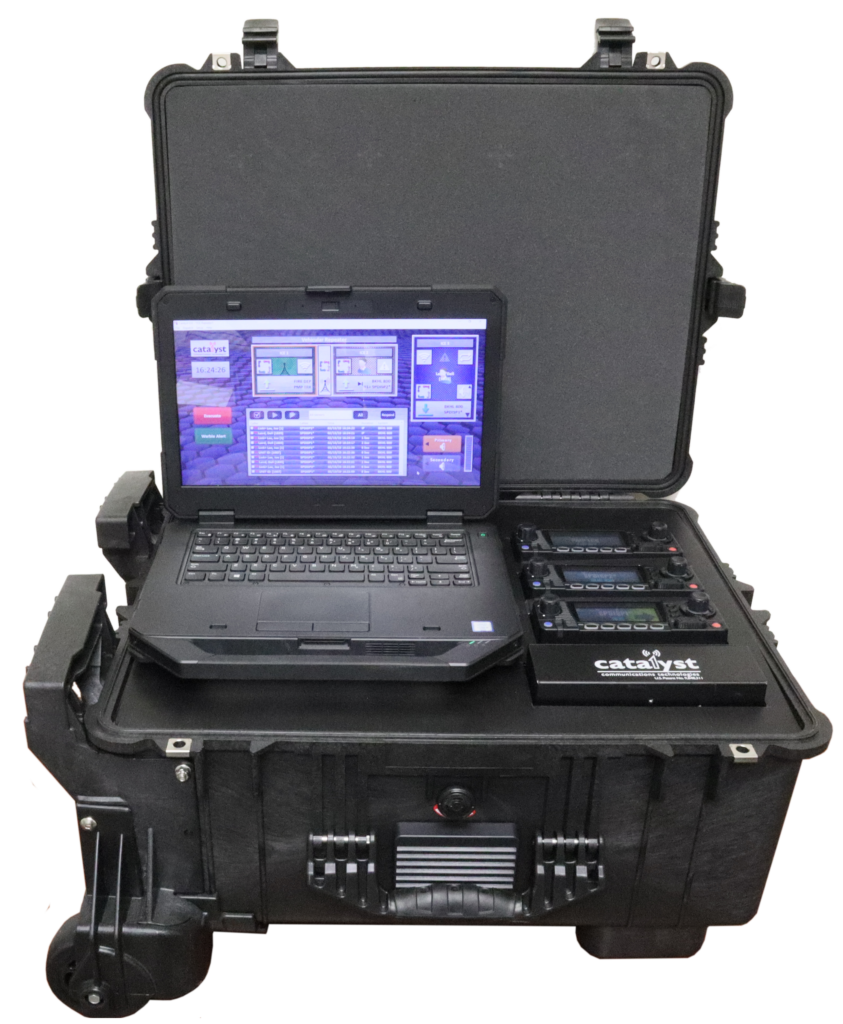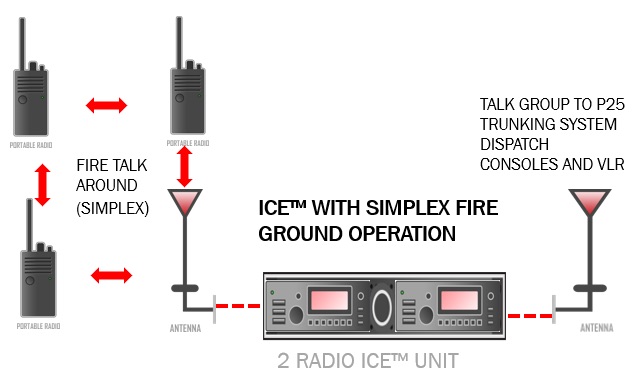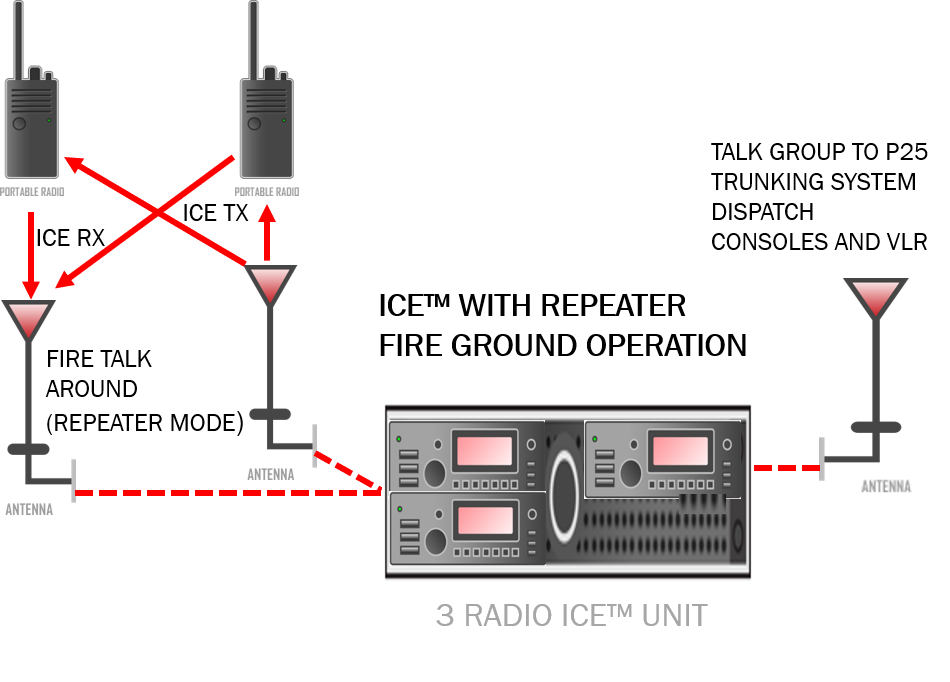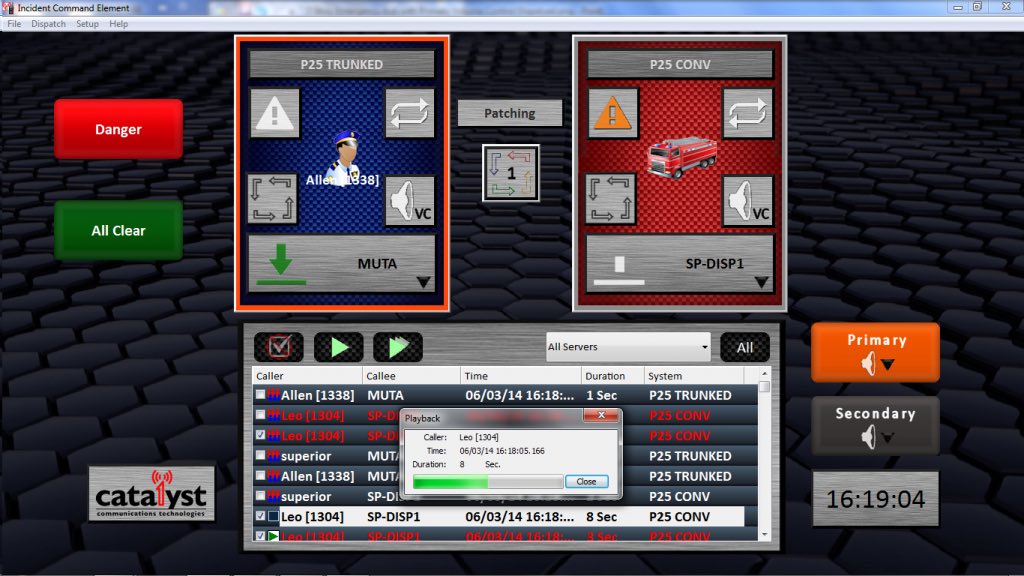Incident Commander Element (ICE™) is a communications tool that provides transportable radio communications, command, and control where radio communications is uneven or does not exist. Typically, these applications include incident command in geographies with poor radio communications, or in-building incidents – especially fire – where radio communications may be compromised.
ICE™ is specifically designed to work with L3Harris mobile radios and is especially well suited to the multiband XL-200M radio, providing Project 25 (P25) digital and conventional analog on VHF, UHF-L, UHF-H and 700/800 MHz bands. More recently ICE™ has been fitted with L3Harris’ XL-200M radio. These units provide enhanced graphics and control for radio voice communications across multiple frequency bands and multiple types of radio systems including Project 25, EDACS™, MDC 1200, and conventional. ICE™ provides essential information for fire ground, emergency medical, special rescue, utility restoration and other public safety and critical infrastructure incidents. A single laptop computer is all that is needed to control up to four mobile radios and provide the control and user interface that can be operated in stand-alone mode or linked back to the agency’s primary radio system and to other radio channels as needed.
This rugged, compact, and efficient solution can be purchased in a robust travel case or installed in a vehicle.

ICE™ in a Simplex Fire Ground Application
ICE™ may be configured with two, three or four mobile radios. With two radios operational, one radio is typically operating in full P25 trunked mobile radio mode. The second radio is operating in simplex mode (single frequency used for transmit and receive). In this mode, ICE™ can allow full featured trunking and simplex operation and can link the two to allow fire ground communications to be linked to the trunked LMR radio system for access by dispatch consoles and other trunked radio talk groups.
The Incident Commander can easily select an alternative simplex channel and alternative trunked talk group or modify the link between them. With a third or fourth mobile radio, the Incident Commander can simultaneous monitor additional simplex channels, even in different frequency bands, and trunked talk groups.
ICE™ can provide a running list of calls with the First Responder’s radio’s unique ID and record fire ground communications locally as well as transfer those calls to the trunked system for capture by the trunked radio system’s Voice Logging Recorder – essential for subsequent incident review or training.
ICE™ in a Repeater Fire Ground Application – Enhanced Digital Vehicular Repeater Application
In this application, ICE™ is configured with three mobile radios. In this operational mode, two of the radios are operational in a “repeater” mode and one is operational in full P25 trunking mode. One radio is operating in transmit only mode (single frequency used for TX) and one radio is operating in receive only mode (single frequency is used for RX).
These units use software to route the audio as needed to replicate “repeater” mode for the Fire Talk Group. In this mode, ICE™ can allow full featured trunking and repeater operation, and can patch the two to allow fire ground communications to be linked to the trunked LMR system for access by dispatch consoles and other trunked radio talk groups.
ICE can provide a running list of calls with the First Responder’s radio’s unique ID and record fire ground communications locally as well as transfer those calls to the trunked system for capture by the trunked radio system’s Voice Logging Recorder – essential for subsequent incident review or training.
Especially useful for fire incidents, these units, as a combined digital repeater and incident command, provide for the ability of First Responders to better communicate in a number of important ways:
- Incident Commander outside the building to First Responders in the building.
- First Responders to First Responders within the building.
- First Responders emergency call (via emergency button) both inside and outside of the building to the Incident Commander and the subsequent audio to other First Responders both inside and outside the building.
- Support for communications between Portable and Mobile Subscriber Units on the Fire Ground that are programmed for the selected conventional frequency pair with limitation on the number of units or radio manufacturer.
- All communications received or transmitted by ICE™ is recorded, stored, and accessible.
- Dispatch console operators can monitor communications within the trunked radio system’s coverage area from dispatch consoles on the system.
When fire fighters or other public safety or critical infrastructure officials choose to operate their two-way radios in talk-around or local repeat mode, it can be difficult to coordinate in the absence of communication with the main dispatch center. ICE allows the Incident Commander to monitor voice communications from these radios across the primary frequency bands using one integrated tool. Commanders see a running list of which radio placed each call with a time stamp. Emergency messages are highlighted and saved on the device and can be managed from it. The audio can be recorded, saved locally, and replayed on-scene or later. Pre-programmed alert voice messages or tones can be broadcast with a single press.
Key features include powerful local patching to create a Digital Vehicular Repeater or connect multiple agencies, recording of audio and the associated Meta data (Unit ID, Emergency, etc.) with Instant Playback, rapid access to hundreds of channels across multiple frequency bands, and a simple set of graphical controls designed for fire fighters, policemen, and other first responders.
ICE™ can link two mobile radios together to patch Talk Around traffic to the local trunked radio system. Catalyst technology dynamically manages the audio flow so that syllables are not lost. Trunked radio systems vary in the amount of time it takes to gain access to a channel. These units can store the audio until the trunked system is ready to receive it and then transmit the audio to the trunked system, the dispatch center, and your primary logging recorder.
Many interoperability solutions in the marketplace provide the ability to patch together one or more radios and link talk groups within those radios. By adding a Dispatch capability to an interoperability solution, an Incident Commander has greater control over radio communications and can modify interoperability patches as needed.
When public safety officials are operating in talk-around or local repeater mode, their conversations can go unrecorded. ICE provides the option to record the currently monitored channels on each local device. Typically, as much as one week of actual talk time through a mobile radio can be stored on these units, allowing for simple review and sharing during the incident or afterwards.
Additional Features
Two, three or four multiband and/or multiprotocol radios can be used to provide interoperability between VHF, 700 MHz, and 800 MHz as well as Project 25, EDACS™, MDC-1200, and conventional.
ICE allows the Incident Commander to rebroadcast transmissions from local units at a higher power on a different frequency so on-scene responders can communicate with one another. The unit can be programmed with multiple repeater pairs and the two radios synchronized so that the two mobile radios change channels together, automatically, reducing operator error.
A single laptop computer running Catalyst software can control mobile radios, record radio traffic and metadata, and provide a user friendly graphical interface.
ICE™ is optimized for the L3Harris XL-200M mobile radio as an integral control station component. With this radio, agencies are able to use a single transceiver to scan between VHF, UHF-L, UHF-H, 700, and 800 MHz frequencies, saving space, power, and cost.
Tune ICE to the desired channel of a recent call with one click.
Catalyst can configure these units with a custom layout and stage it with your radios so that when you need communications, it will be ready. Just turn it on and immediately enhance your communications and record keeping.




